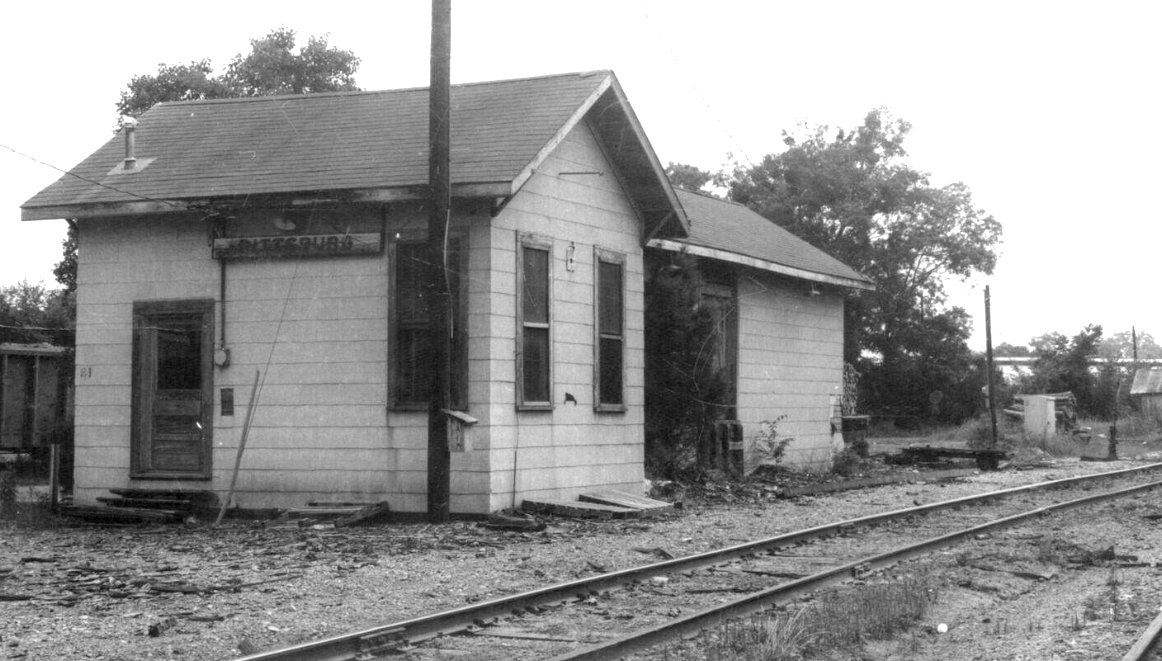Texas Railroad History - Tower 195 - Pittsburg
A Crossing of the Louisiana & Arkansas Railway and the St.
Louis Southwestern Railway
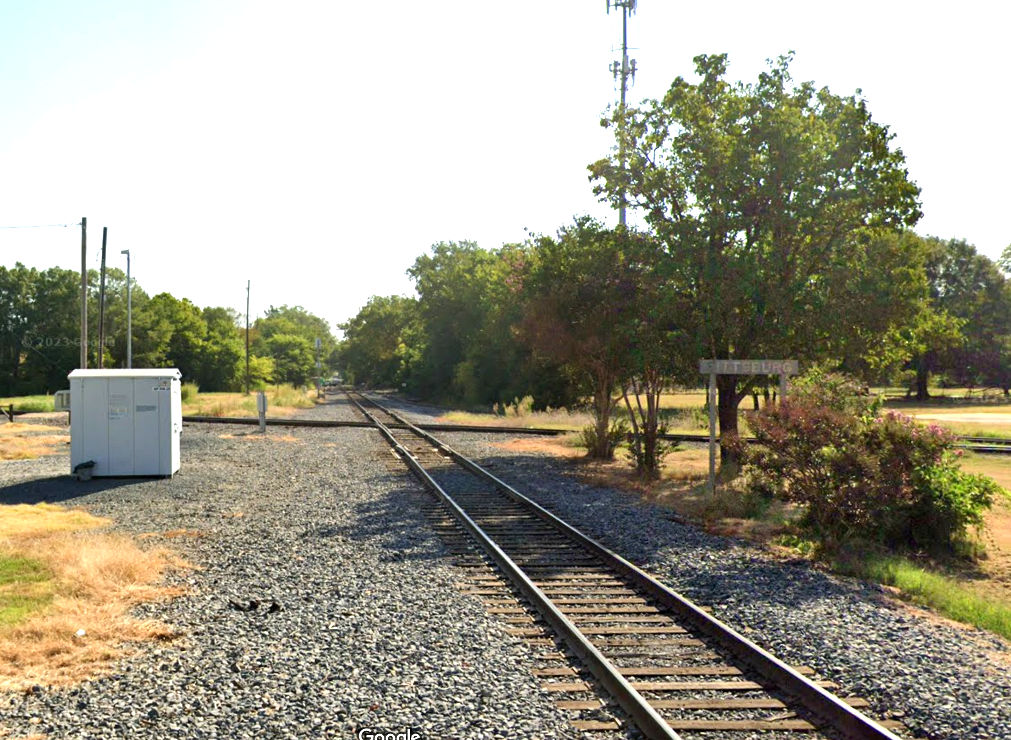 |
Left: Google
Street View supplies this August, 2023 image of the grade crossing in
Pittsburg which dates to 1880, one of the oldest rail junctions in
Texas. Although the view is geographically northeast along the Kansas
City Southern (KCS) main line, the tracks eventually turn southeast to
Jefferson, continuing to Shreveport. In the opposite direction, the KCS
line goes to Greenville and Dallas. KCS' ownership of this route dates
back to its merger with the Louisiana & Arkansas Railroad in 1939.
The track crossing the KCS at grade belongs to Union Pacific (UP.) It is
a main line of Cotton Belt heritage between Big Sandy (south, right) and Texarkana
(north, left.) UP has another main line (of Texas & Pacific heritage)
between those same endpoints that routes through Marshall and is paired
with this one for directional running. As a consequence, almost all of
UP's traffic through Pittsburg is
southbound. |
Pittsburg was founded in 1855, named for local
settler William H. Pitts. For nearly forty years, it was spelled
Pittsburgh like the city in Pennsylvania, but the Post Office dropped the trailing h from the town's name in 1893.
This was done for compliance with a general rule adopted by the U. S. Board of Geographic
Names in 1891 -- a rule sufficiently noteworthy that there's an entire
Wikipedia article
about it! (hat tip Don Harper) The first railroad
into
Pittsburg was the East Line & Red River (EL&RR)
Railroad at the end of 1877. It had been chartered as a narrow gauge line by businessmen in the town of
Jefferson, a major river port at the time. They
were concerned that the rapid expansion of railroad construction underway in
Texas would derail trade through Jefferson's river port. Their plan was to build
west to McKinney, a town on the Houston & Texas Central (H&TC) Railroad main
line out of Houston that terminated at Denison, 42
miles north of McKinney. Denison was near the Red River bridge that had been
opened several years earlier by the Missouri, Kansas & Texas (MK&T, "Katy") Railroad.
The EL&RR founders expected that some Midwest commodities carried south by the
H&TC might opt to take a McKinney to
Jefferson routing where freight could be
forwarded to New Orleans via Jefferson's river port. Their business plan was unsound, but
Jefferson's civic leaders were desperate to preserve the economy of
the sixth largest city in Texas. (They failed; Jefferson's population
declined 55% from 1870 to 2020.) Finances forced
the EL&RR construction
to stop at Greenville in 1880, 32
miles shy of McKinney. The EL&RR remained stalled there until it came under
the control of rail baron Jay Gould.
Gould controlled the Missouri
Pacific (MP), a major Midwest railroad in which he had a large ownership
position. Gould wanted to penetrate the Texas market with his eye on the major
port of Galveston as the ideal export destination
for Midwest grain. Gould needed a Texas railroad under his control and he
chose the Katy. Through a cleverly executed long range plan, Gould was able to
be elected President of the Katy in December, 1879 despite owning very little Katy stock. Gould
proceeded to lease the Katy to MP
in December, 1880. As a result of accounting and operating policies tilted
heavily toward MP, its stockholders (mostly Gould) would reap the benefits of
the Katy lease, much to the eventual chagrin of the Katy's stockholders.
By April, 1881, Gould had also gained financial control of the Texas & Pacific (T&P)
Railway and soon thereafter leased it to MP. In June,
1881, Gould bought the EL&RR and assigned it to the Katy. The Katy and the
EL&RR connected at Greenville, and the T&P had a main line through Jefferson, the EL&RR's
eastern endpoint. Gould perceived the EL&RR as a good fit for his evolving
Texas rail network and he directed the Katy
to complete the remaining 32 miles of EL&RR narrow gauge track to McKinney as
originally planned. This segment of the EL&RR was converted to standard gauge in
1887; the remainder was converted in 1892.
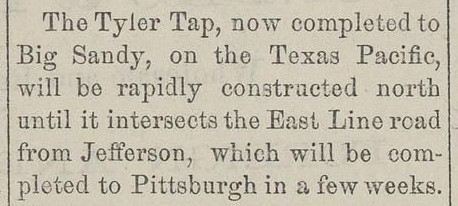 |
Left:
The
Daily Fort Worth Standard of October
17, 1877 reported that the Tyler Tap railroad would be "rapidly constructed
north" from Big Sandy to intersect the EL&RR, but this was typical
railroad construction bluster. Two and a half years later, the Galveston Daily News
reported that the tracks had finally reached
Pittsburg, only forty miles north of Big Sandy, on April 1, 1880.
The Tyler Tap Railroad
had been chartered in 1871 to bring rail service to Tyler
which was finally accomplished
with the T&P connection at Big Sandy. The Tyler
Tap changed its name to the Texas & St. Louis (T&SL) when it built 107 miles from Big Sandy
through Pittsburg to Texarkana, plus additional tracks into Arkansas and Missouri.
Westward expansion deeper into Texas also occurred in 1880-81 with
tracks from Tyler to Corsicana (75 miles),
continuing to Waco
(56 miles.) By 1882, the Texas portion of the T&SL was profitable
despite stiff competition from several railroads. |
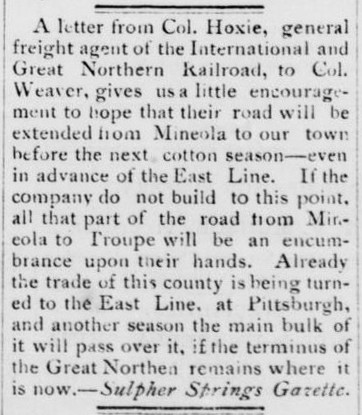 |
Left:
The Denison Daily News of
January 23, 1878 quotes the Sulphur
Springs Gazette warning the International & Great Northern
(I&GN) Railroad that it would lose business to the EL&RR at Pittsburg if
it did not extend its route north from Mineola.
The EL&RR was building toward Sulphur Springs and reached the town in
April, 1879. Despite the admonishment, the I&GN never built north from
Mineola.
Right:
The Galveston Daily News of
December 17, 1880 announced that T&SL trains had begun operating between
Tyler and Texarkana. |
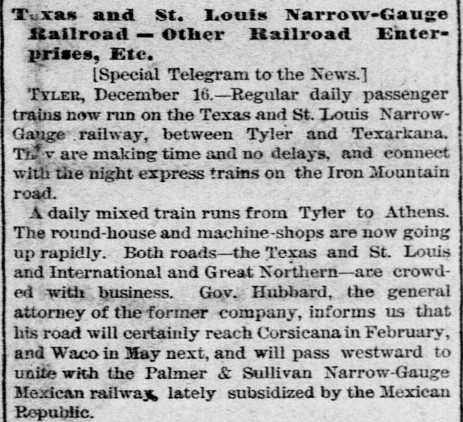 |
Unfortunately for the T&SL, the expansion into Arkansas and
Missouri had overextended its finances, making capital improvements difficult to
accomplish.
Lacking the lengthy sidings and rolling stock necessary to run single-track rail
lines efficiently, the T&SL went into
receivership in January, 1884. As the financial reorganization
proceeded slowly, the bankruptcy judge grew impatient, forcing the T&SL
to be sold rather than merely reorganized. Selling required dividing it into two
properties, the Texas portion and the Arkansas - Missouri portion, so that the
Texas portion could be headquartered in Texas to comply with state law regarding
track ownership. Against the advice of the Receiver, Samuel Fordyce, who
believed there were operational issues that would inhibit profitability, the
plan was executed and the assets were sold to a bondholders' committee in early
1886. In February, the bondholders' committee deeded the Texas
assets to the St. Louis, Arkansas & Texas (SLA&T) Railway in Texas, a new company
created for the purpose of restarting the
Texas portion of the railroad. In April, the Arkansas - Missouri assets were similarly
deeded to the St. Louis, Arkansas & Texas Railway in Arkansas and Missouri.
The management was the same for both companies, with Sam Fordyce as President.
Near the end of that year, the 1886 general election resulted in a new Texas
Attorney General, James S. Hogg, taking office. Hogg campaigned on a promise to go after the railroads for various
infractions, and he quickly began filing lawsuits. When all of the legal dust
settled several years later, Hogg had been elected Governor of Texas, Gould was no longer President of the Katy (he'd
been fired by its stockholders), the Katy was no longer under lease to MP, and
the Katy's ownership of the EL&RR had been declared unlawful by the Texas
Supreme Court, a ruling that forced the EL&RR into receivership with its
charter forfeited. The problem was that state law in 1870 had granted the Katy permission to use its
Kansas charter as the basis for crossing into Texas over their planned Red
River bridge. Under Gould's control, the Katy had proceeded to build south
through Fort Worth, Waco
and Temple, ultimately heading for Houston. As the Katy lacked both a Texas charter and a Texas
headquarters, the court ruled the expansion illegal. A new charter for a
Texas-based Katy subsidiary would need to
be approved by the Texas Legislature, and until then, it could not own any other
Texas railroads including the EL&RR.
The Gould era at the Katy coincided with the
expansion of the T&SL in Texas. Developments were followed closely by
the
Galveston Daily News, the newspaper of record in Texas in
the 19th Century. Published daily when most Texas newspapers were
weekly, it had by far the largest readership, in part because
Galveston was the largest city in Texas. And with excellent rail
connections from Galveston onto the Texas mainland, the newspaper was widely
circulated. All major railroads in Texas advertised their schedules in
the Galveston Daily News.
Right:
The T&SL's first ad in the Galveston
Daily News ran in the issue of January 21, 1881. It is
historically significant
because it shows the T&SL claiming the moniker "Cotton Belt Route".
While "cotton belt" was a common geographic and geopolitical term for
various cotton-producing areas in the South, this
is the first known instance of the T&SL using "Cotton Belt Route"
as a marketing slogan for the railroad. The public embraced it; "Cotton Belt" would
be the nickname of an operational railroad for the next 110 years.
As successor to the T&SL, the SLA&T became the new iteration of the
Cotton Belt in 1886. It would not be the last. |
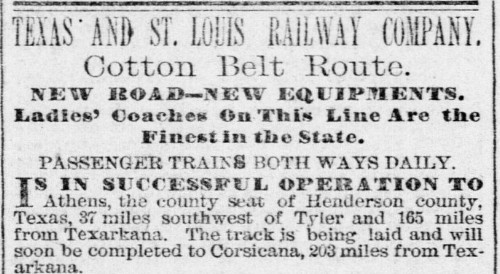 |
While Gould had been
fighting Hogg, the SLA&T had begun its operations as the new Cotton Belt. It owned a
single main line between Bird's Point, Missouri and Gatesville, Texas via
Texarkana. In 1887, the SLA&T began building a branch line west from Mount
Pleasant, intending to compete with Gould on eastern and Midwest traffic to
Fort
Worth. At Commerce fifty-seven miles west of Mount Pleasant, the line split into two branches: one
to Sherman via Whitewright
(much of the right-of-way is now Texas Highway 11) and one to Fort Worth. The
Fort Worth branch routed via
Greenville and Plano,
passed north of Dallas (where a spur was later built into downtown), continued west through
Carrollton, and then turned southwest to Fort
Worth. The lengthy branch lines increased company-wide maintenance expenses
significantly while vigorous competition from Gould impacted the revenue on both branches. Gould knew that the
SLA&T was in a financial squeeze, and in 1888, he offered Fordyce a
secret arrangement to have the Cotton Belt cooperate with MP on
traffic through Texarkana. Fordyce accepted and Gould began to accumulate
financial leverage over the SLA&T through loans and stock purchases, positioning
him to guide its inevitable reorganization. The combined
SLA&T companies were soon unable to meet their financial obligations and they
went into receivership in May, 1889. Fordyce was again named Receiver, but with
A. H. Swanson appointed to work with him due to legal questions regarding
Fordyce's eligibility to be the Receiver for the Texas company. After a couple of years of reorganization,
yet
another new company was chartered. Gould wanted
the legal name to be Cotton Belt Railroad, but St. Louis Southwestern
(SSW)
Railway was chosen instead. It was incorporated as two legal entities --
one in Texas and one in Missouri -- in January, 1891. Fordyce was again named
President; Jay Gould's son Edwin was named Vice President.
Meanwhile, the
Katy drama was still playing out in the Legislature and in Texas newspapers. The
Katy's new charter was filed on
October 28, 1891 and approved by the Legislature establishing the Missouri,
Kansas & Texas Railway Co. of Texas to be headquartered at Denison as a
wholly-owned subsidiary of the parent Katy corporation. The Texas subsidiary
would own many of the Katy's former Texas rail lines, but not the International
& Great Northern (I&GN), a large Texas railroad Gould had acquired and
transferred to the Katy.
The Legislature would not allow the Katy to own the I&GN, so the Katy had little
choice but to sell it back to Gould. The EL&RR was also omitted from the
Katy's Texas charter; its outstanding debt would have burdened the Katy
financially. Instead, the EL&RR was sold out of receivership to a committee of
its bondholders in 1893 and they deeded it to the newly chartered Sherman, Shreveport & Southern
(SS&S) Railway. The SS&S
operated the route successfully for several years and extended the tracks thirty miles southeast from Jefferson to Waskom in 1900.
There, a
connection was made to the Vicksburg, Shreveport & Pacific Railroad
providing a route into Shreveport.
After operating successfully for the remainder of the 1890s, the Katy
decided it wanted to re-acquire its former EL&RR line. In 1899, the Katy asked
the Legislature to grant various charter revisions including permission to
acquire the SS&S. The Legislature leveraged the Katy's desire for the SS&S by
requiring the Katy to first extend its tracks from
San Marcos
south to San Antonio as a means of providing north
/ south competition for the I&GN. The Katy completed the
construction and was able to acquire the SS&S in May, 1901.
 |
Left:
This map provides an overview of the railroads in northeast Texas c.1900
(not all railroads shown.)
At Texarkana, the T&P connected with
Gould's MP (not shown) which went northeast to St. Louis. Immediately
south of Texarkana, the T&P crossed the KCS at
Tower 28.
KCS was chartered in 1900 to acquire the Kansas City, Pittsburg & Gulf
(KCP&G) and its subsidiaries which operated a line from Kansas City to
Port Arthur. The track segment south of
Texarkana belonged to the Texarkana & Fort Smith (T&FS) which
became a KCS subsidiary and was formally merged into KCS in 1943.
In 1939, KCS merged with the Louisiana & Arkansas Railroad which gave it
ownership of the former EL&RR / SS&S tracks between McKinney
and Waskom. It abandoned the tracks between Karnack and Waskom when it built
a cutoff from Karnack directly to Shreveport in 1956.
Also in
1956, the Katy line from Greenville to Mineola was abandoned. Besides
the Katy tracks into Mineola and the SS&S tracks from Karnack to Waskom,
all other tracks on this map remain intact, mostly under UP or KCS
ownership. |
Jay Gould died at the end of 1892. His elder son George
took over the family business and replaced Jay in many executive
positions. George's younger brother Edwin was a Vice President of the
SSW, the new Cotton Belt, in which the Gould family had a substantial investment.
When Fordyce left the SSW in 1898 to become the Receiver for the KCP&G (and
subsequently President of KCS), Edwin took over as SSW President. The SSW was a success and the Cotton Belt operated
independently into the 1920s. In 1925, Edwin stepped down as
President and the Gould family sold its interests in the SSW. In 1932, the SSW became controlled by
Southern Pacific (SP) but
continued to operate as an independent subsidiary until it was fully merged into
the parent company in
1992. In 1996, SP was acquired and merged into UP, hence Cotton Belt heritage
tracks are now mostly owned by UP.
The Katy entered
bankruptcy in 1915 and was operated by a Receiver under court supervision
until 1923. Its reorganization out of this receivership resulted in a new name: the
Missouri - Kansas - Texas Railroad ("M-K-T" or "MKT", but mostly just "the
Katy".) Among various changes resulting from the reorganization, the Katy's
former EL&RR / SS&S line from McKinney to Waskom was sold to the newly chartered
Louisiana Railway & Navigation Co. (LR&N), a Texas-based company affiliated with the parent
LR&N based in Louisiana. In 1928, the Delaware-chartered Louisiana & Arkansas
(L&A) railroad acquired an older railroad of the same name and also leased the LR&N. The LR&N changed its name to the Louisiana,
Arkansas & Texas (LA&T) in 1930 to better reflect its operations across three
states.
In 1932, the L&A began serving Dallas via trackage rights
obtained by the LA&T (still under lease) on the Katy's line from Greenville. In
1937, the Katy chose not to renew the LA&T's rights into Dallas, so the LA&T
began serving Dallas via Farmersville over tracks of the Gulf, Colorado & Santa
Fe Railway. In July, 1939, the L&A formally acquired the LA&T. Three months
later, the L&A merged with KCS through
an exchange of stock. KCS became the parent company and the L&A operated as
a subsidiary (it would be fully
merged in 1992.) In 1940, the L&A abandoned its tracks beyond Farmersville
to McKinney. Lacking adequate traffic, Santa Fe eventually sold its line from Dallas to
Paris that passed through Farmersville. KCS acquired
the tracks between Farmersville and Dallas and made it a seamless extension of
the line from Greenville to Farmersville. This remains an important main line route for KCS
between Shreveport and Dallas / Fort Worth. KCS has
recently merged with Canadian Pacific to become CPKC.
Despite two
active main lines, the crossing at Pittsburg was not interlocked until the late
1940s, identified by the Railroad Commission of Texas (RCT) as Tower 195. A
Cotton Belt timetable from July, 1944 lists the crossing at Pittsburg as neither
interlocked nor gated, but an April, 1949 L&A timetable lists the crossing as
interlocked. There was no tower structure; the interlocker was most likely
automatic as RCT had begun authorizing automatic interlocker installations in
1931. The reason for the delay in establishing an interlocker at Pittsburg most
likely related to the diamond's proximity to both depots and numerous industry
sidings nearby. Trains were forced to
operate slowly through Pittsburg, hence a delay
to stop at the crossing was a negligible time penalty. As the railroads began
running longer trains that bypassed the sidings and depots at Pittsburg, it made
sense to interlock the crossing.
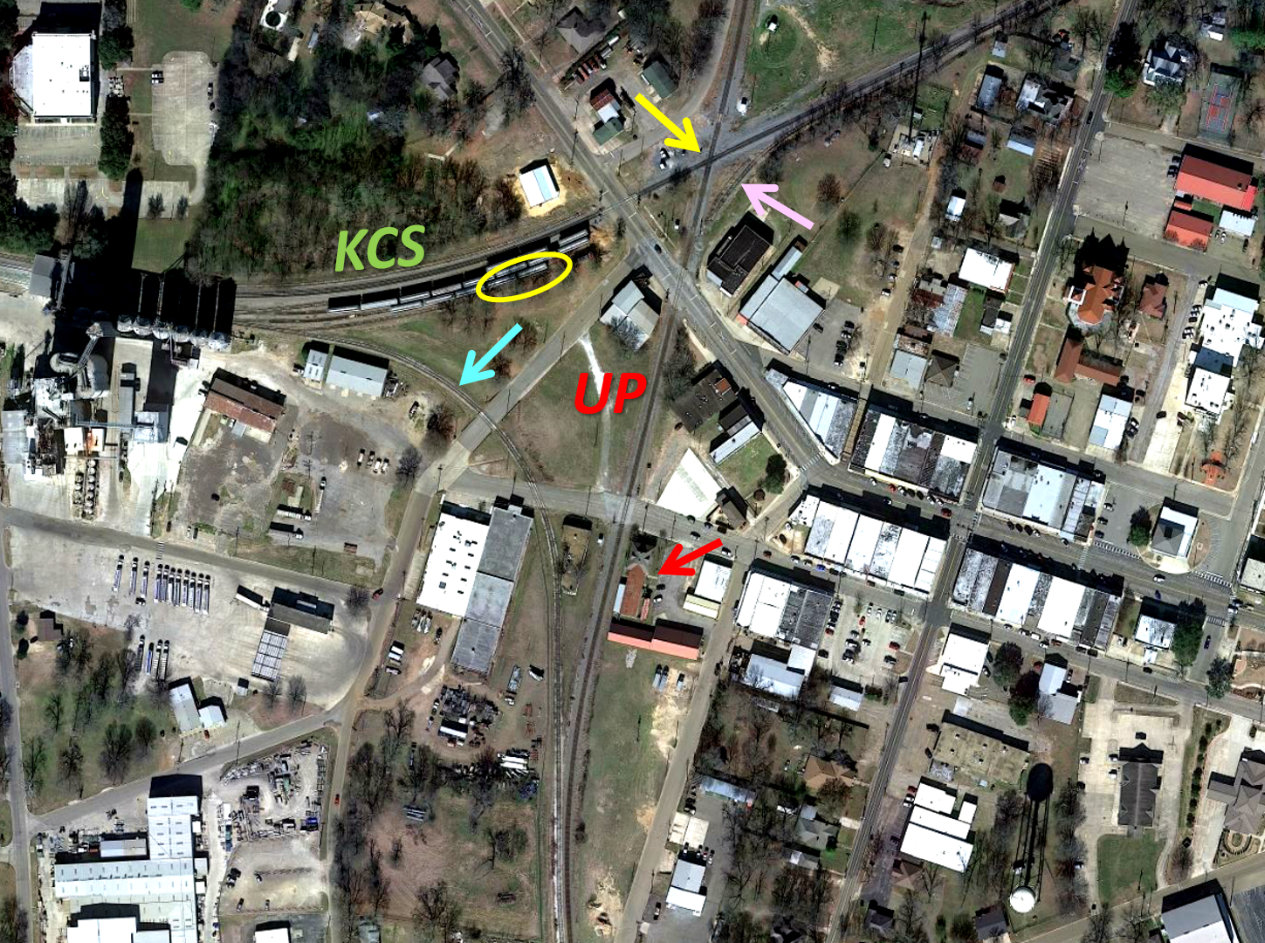
Above: This annotated satellite view of the Tower 195
crossing was captured on January 28, 2022 (Google Earth.) UP's north / south
tracks of Cotton Belt heritage cross KCS' northeast / southwest tracks of EL&RR
/ Katy / L&A heritage at the yellow arrow. Nearby, the pink arrow points to a
connecting track that dates back to at least 1957. It remains connected to a
switch on the KCS track, but its connection to UP's track was removed sometime
prior to 2008. The KCS siding tracks southwest of the diamond (hosting several
railcars) occupy the site (yellow oval) of the former L&A depot which is no
longer standing. The red arrow points to the Cotton Belt depot which has been
preserved. A connecting track (blue arrow) facilitates service between UP's main
line and an industrial facility located beside the KCS tracks at far
left. The facility is owned by Pilgrim's Pride, a major food production company
that evolved from a feed store that opened in Pittsburg in 1946.
Below: The
interlocking equipment at the crossing has changed in recent years as evidenced
by these two
Google Street Views facing southeast near the diamond. The 2013
image (left) shows a post near
the diamond that housed manual override controls for the automatic interlocker.
Perhaps the boxes mounted on the posts in the 2023
image (right) serve the same purpose.
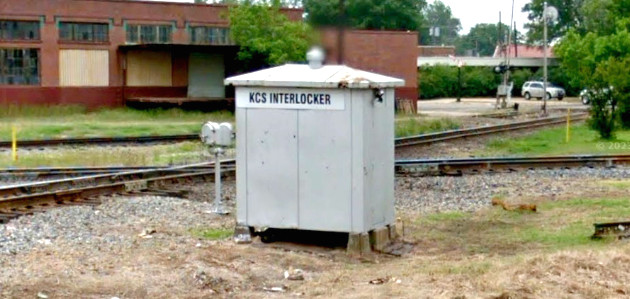

Below Left: Google Street View
looking north along UP's tracks in 2018
Below Right: In an unusual arrangement, the KCS main
line passes under a shade structure beside the Pilgrim's Pride facility (Google
Street View, August, 2023.)
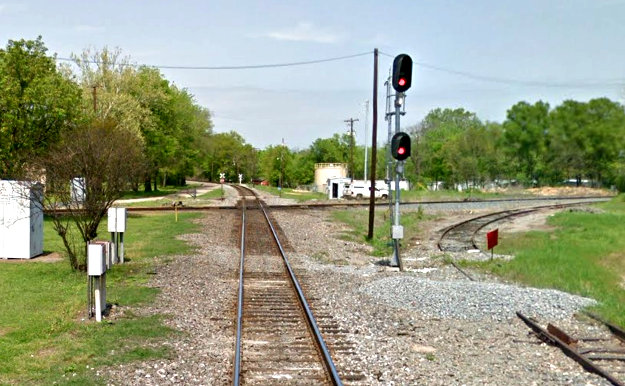
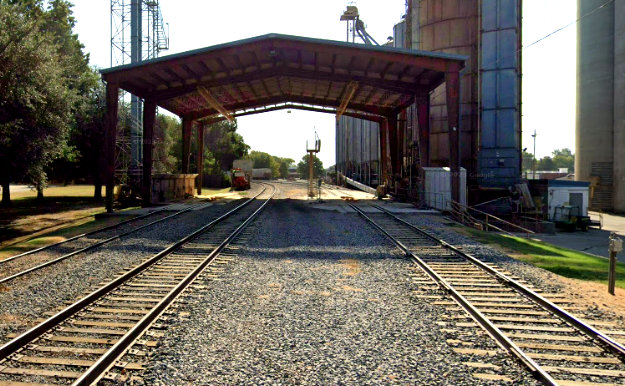
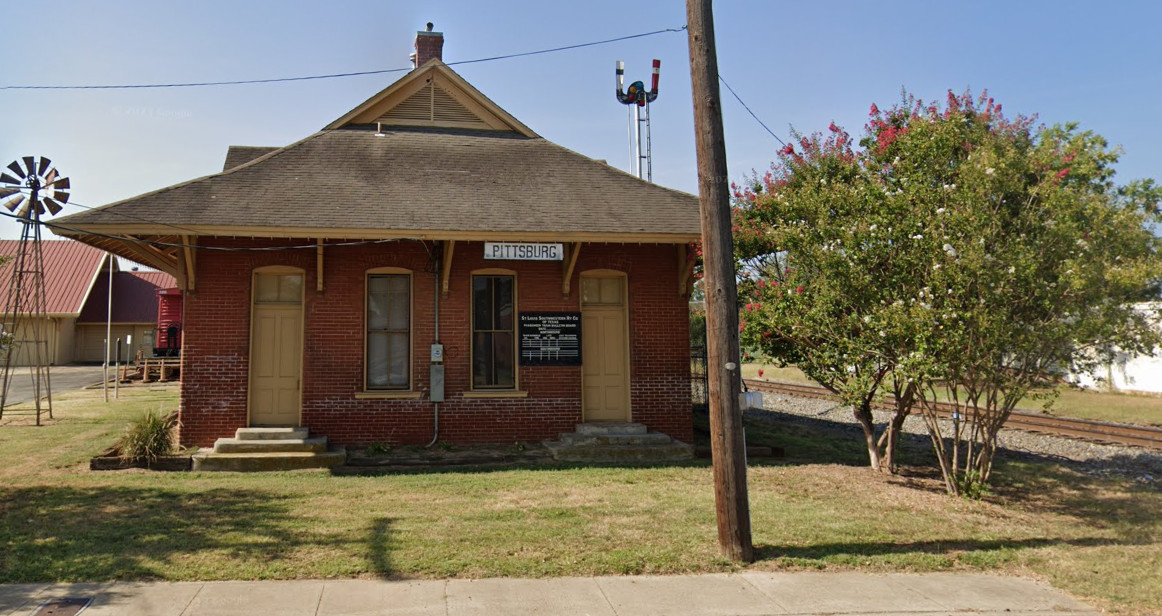
Above: This Google Street View from August,
2023 shows Pittsburg's Cotton Belt depot which currently houses the
Northeast Texas Rural Heritage
Museum. The depot is approximately 750 ft. south of the crossing diamond.
Below: Pittsburg's L&A depot,
1976 (H. D. Connor collection)
